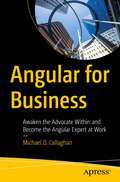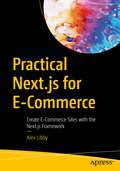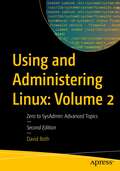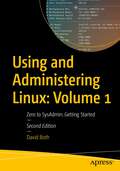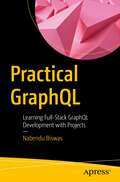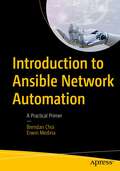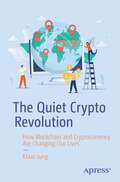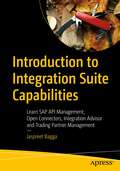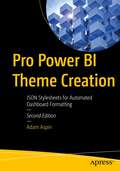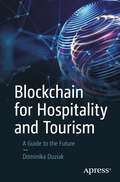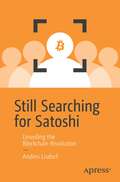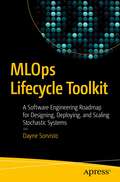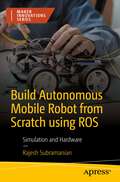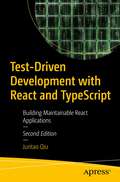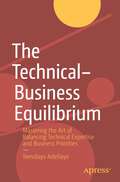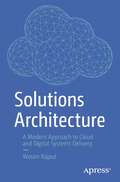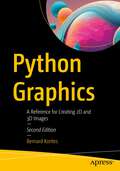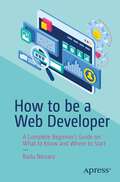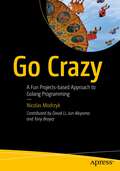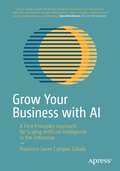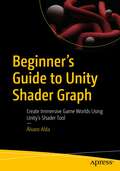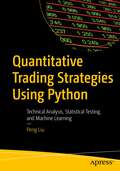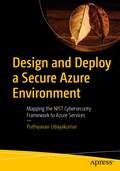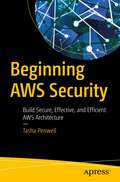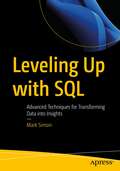- Table View
- List View
Angular for Business: Awaken the Advocate Within and Become the Angular Expert at Work
by Michael D. CallaghanWritten from author Michael D. Callaghan's personal experience teaching Angular to web development teams, this book will serve as a practical guide to help you adopt Angular for your organization. This book consists of a series of essays related to Angular development, adoption, and the wider eco-system designed to appeal to experienced web developers and managers who have some experience with Angular and are looking to adopt and integrate it into their business for their web development projects.You'll begin with an introduction to Angular15, along with associated frameworks and tools such as Typescript, Firebase RxJS and Docker. You'll then explore Angular components, progressive Web Apps (PWA’s) APIs, Test-driven development, testing, security and the basics of agile project management. This includes how to train your team and effectively communicate with management and key stake-holders within your organization while transitioning onto an Angular workflow. What You'll LearnAdvocate for Angular from within your organization Create a simple "no-code" Angular componentKeep up with Angular releases for enterprise projects Understand service APIs from both the producer and consumer point of viewTest APIs quickly and using FirebaseImplement the basics of agile project managementWho This Book Is ForExperienced web developers and managers with some knowledge of Angular and the related JavaScript eco-system who are looking at adopting Angular for enterprise projects and those who need to get co-workers up to speed with an Angular-based workflow.
Practical Next.js for E-Commerce: Create E-Commerce Sites with the Next.js Framework
by Alex LibbyLeverage the power of Next.js to quickly produce efficient e-commerce sites. This project-oriented book will simplify the process of setting up a starter e-commerce site using Next.js from start to finish, creating a usable e-commerce offer with little more than a text editor or free software. It will equip you with a starting toolset you can use to develop future projects, incorporate into your existing workflow, and help you to take your websites to the next level, reducing reliance on tools that are bloated, prone to being hacked, and not the most efficient. Practical Next.js for E-Commerce is an excellent resource for getting started creating and manipulating e-commerce sites using a static site generator approach. It takes the view that you don’t have to create something complex and unwieldy; you can build something quickly, then extend it using the power of the API or plugins over time, without sacrificing speed or features. What You Will Learn Implement e-commerce sites using Next.jsExplore some of the options for architecting an e-commerce site using this frameworkWork through a project from start to finish, understanding what can be achieved using Next.js, and where other tools may need to be brought into play Who This Book Is For Web developers and designers who are interested in learning how to implement the Next.js framework in an e-commerce capacity.
Using and Administering Linux: Zero to SysAdmin: Advanced Topics
by David BothLearn to be a Linux sysadmin and an expert user of the Linux operating system, even with no previous Linux experience. This second edition of the popular and highly rated Linux self-study training course has been fully updated to Fedora Linux 37 with expanded and revised content and figures as well new chapters on the BTRFS file system, using Zram for swap, NetworkManager, automation with Ansible, and systemd.Like the previous version, this edition has been reviewed for technical accuracy by a highly respected Linux expert and will prepare you to manage complex systems with ease and equip you for a new career. It has also been reviewed by a student who took this course to ensure its readability and flow for those with little or no previous experience with Linux. This second volume builds upon what you learned in the first and depends upon the virtual network and virtual machine created there.You’ll see how to manage and monitor running processes, discover the power of the special filesystems, monitor and tune the kernel while it is running – without a reboot. You’ll then turn to regular expressions and the power that using them for pattern matching can bring to the command line, and learn to manage printers and printing from the command line and unlock the secrets of the hardware on which your Linux operating system is running.Experiment with command line programming and how to automate various administrative tasks, networking, and the many services that are required in a Linux system. Use the logs and journals to look for clues to problems and confirmation that things are working correctly, and learn to enhance the security of your Linux systems and how to perform easy local and remote backups. What You Will LearnUnderstand Logical Volume Management, using file managers, and special filesystemsExploit everything is a filePerform command line programming and basic automationConfigure printers and manage other hardwareManage system services with systemd, user management, security, and local and remote backups using simple and freely available tools Who This Book Is For Anyone who wants to continue to learn Linux in depth as an advanced user and system administrator at the command line while using the GUI desktop to leverage productivity.
Using and Administering Linux: Zero to SysAdmin: Getting Started
by David BothLearn to be a Linux sysadmin and an expert user of the Linux operating system, even with no previous Linux experience. This second edition of the popular and highly rated Linux self-study training course has been fully updated to Fedora Linux 37 with expanded and revised content and figures as well new chapters on the BTRFS file system, using Zram for swap, NetworkManager, automation with Ansible, and systemd.Like the previous version, this edition has been reviewed for technical accuracy by a highly respected Linux expert and will prepare you to manage complex systems with ease and equip you for a new career. It has also been reviewed by a student who took this course to ensure its readability and flow for those with little or no previous experience with Linux.In this first volume of the training course series, you will learn about operating systems in general and Linux in particular, and explore the Linux philosophy for SysAdmins in preparation for the rest of the course. This book provides you with the tools necessary for mastering user management; installing, updating, and deleting software; and using command line tools to do performance tuning and basic problem determination.You'll begin by creating a virtual network and installing an instance of Fedora – a popular and powerful Linux distribution – on a VirtualBox VM that can be used for all of the experiments on an existing Windows or Linux computer. You’ll then move on to the basics of using the Xfce GUI desktop and the many tools Linux provides for working on the command line including virtual consoles, various terminal emulators, Bash, and other shells.Explore data streams and the Linux tools used to manipulate them, and learn about the Vim text editor, which is indispensable to advanced Linux users and system administrators and be introduced to some other text editors. You’ll also see how to install software updates and new software, learn additional terminal emulators, and some advanced shell skills. Examine the sequence of events that take place as the computer boots and Linux starts up, configure your shell to personalize it in ways that can seriously enhance your command line efficiency, and delve into files and filesystems.What You Will LearnInstall Fedora Linux and basic configuration of the Xfce desktopAccess the root user ID, and the care that must be taken when working as rootUse Bash and other shells in the Linux virtual consoles and terminal emulatorsCreate and modify system configuration files with Use the Vim text editorExplore administrative tools available to root that enable you to manage users, filesystems, processes, and basic network communicationsConfigure the boot and startup sequencesWho This Book Is For Anyone who wants to learn Linux as an advanced user and system administrator at the command line while using the GUI desktop to leverage productivity.
Practical GraphQL: Learning Full-Stack GraphQL Development with Projects
by Nabendu BiswasMaster the query language that is revolutionizing how websites are developed and built. This book is a hands-on guide to GraphQL, and will teach you how to use this open source tool to develop and deploy applications quickly and with minimal fuss.Using a project-based approach, you'll learn how to use GraphQL from the ground up. You'll start with the basics, including set up and key details regarding queries and mutations, before moving on to more advanced topics and projects. Over the course of the book, you will gain a thorough understanding of the web development ecosystem from frontend to backend by building React applications using Prisma Apollo Client and MongoDB.After completing this book, you'll be equipped with the knowledge and skills needed to turbo charge your own enterprise projects.What You'll LearnUnderstand what GraphQL is and how to use itDistinguish between queries and mutations, and how to leverage themGain a greater knowledge of full-stack applications with React, Apollo Server, and Apollo ClientCreate a full stack application with React and PrismaWho This Book Is ForDevelopers and engineers who want to learn about GraphQL so that they can implement in their enterprise React projects. This book is aimed at both backend developers and full stack developers who want to learn to create backend queries using GraphQL.
Introduction to Ansible Network Automation: A Practical Primer
by Brendan Choi Erwin MedinaThis book provides a comprehensive learning journey aimed at helping you master Ansible and efficiently automate a range of enterprise network devices, such as routers, switches, firewalls, Wireless LAN Controller (WLC), and Linux servers. Introduction to Ansible Network Automation combines the fundamentals of three books into one, covering basics of Linux administration, Ansible concepts, and Ansible network automation. Authors Brendan Choi and Erwin Medina have created a structured learning path that starts with the fundamentals and allows you to progressively enhance your skill sets with each chapter. Part I serves as an Ansible primer, guiding you through Linux basics using WSL on Windows 11 and assisting in the setup of your learning environment. Part II covers essential Ansible concepts through practical lab activities involving four Linux servers. In Part III, you will learn how to apply your Linux skills from Part I and the concepts from Part II to real-world scenarios by creating Ansible automation YAML scripts. What sets this book apart is its unique focus on Ansible and Network Automation, combined with a strong emphasis on understanding Linux. It is specifically designed for novice network automation engineers and students, assuming no prior Linux expertise, and provides first-hand experience starting from scratch. It also offers practical insights by sharing real-life examples of Ansible playbooks derived from production enterprise infrastructure, allowing you to gain an understanding of how Ansible can be effectively applied in real-world enterprise network environments. Upon completion of this book, you will have developed foundational skills in Ansible network automation and general Linux administration, and will understand how to apply this newly acquired knowledge to real-life scenarios. What You Will Learn Develop a comprehensive understanding of Ansible and its essential concepts for automating enterprise network devices and applying them to real-world scenariosMaster the basics of Ansible operations within Linux automation and progress to applying Ansible concepts specifically to network device automationExecute Ansible ad-hoc commands and playbooks for a range of network operational tasks, including configuration management, software and system updates, and upgradesWork with real-life examples of Ansible playbooks derived from actual enterprise infrastructure, gaining practical experience in writing Ansible YAML scriptsAcquire the skills to automate network operations using Ansible, streamline network management processes, and replace manual-driven tasks with directives in Ansible playbooks Who is This Book For Network, security, UC and systems engineers, as well as technical leaders, IT managers and network students.
The Quiet Crypto Revolution: How Blockchain and Cryptocurrency Are Changing Our Lives
by Klaas JungCrypto is going to change the world, and for those tired of confusing financial jargon and complicated technical terminology, look no further. This book demystifies the world of cryptocurrencies and blockchain technology and explains in accessible language how it will affect your daily life. In The Quiet Crypto Revolution, Klaas Jung dives beneath the surface of Bitcoin to explore the engine that powers it - blockchain. Far surpassing the confines of cryptocurrencies, blockchain's potential for wide-ranging applications is enormous. It's crucial to understand that cryptocurrencies are merely a single manifestation of blockchain's capabilities. This book casts light on the broader spectrum of blockchain applications and the exciting future of this groundbreaking technology. With a focus on real-world applications, you'll gain a deeper understanding of the key concepts behind the innovative technology of blockchain, equipping you to make informed decisions. Whether you're a tech-savvy individual or a complete newcomer to the world of crypto and finance, this book will arm you with the knowledge and insights you need to understand the impact cryptocurrency and blockchain will have on your future.You WillLook at the future of blockchain technologyReview potential use cases for blockchain beyond cryptocurrencyStudy security strategies to avoid scams in the crypto spaceWho This Book Is ForBeginners who would like to gain a better understanding of cryptocurrency and the technology that supports it.
Introduction to Integration Suite Capabilities: Learn SAP API Management, Open Connectors, Integration Advisor and Trading Partner Management
by Jaspreet BaggaDiscover the power of SAP Integration Suite's capabilities with this hands-on guide. Learn how this integration platform (iPaaS) can help you connect and automate your business processes with integrations, connectors, APIs, and best practices for a faster ROI. Over the course of this book, you will explore the powerful capabilities of SAP Integration Suite, including API Management, Open Connectors, Integration Advisor, Trading Partner Management, Migration Assessment, and Integration Assessment. With detailed explanations and real-world examples, this book is the perfect resource for anyone looking to unlock the full potential of SAP Integration Suite. With each chapter, you'll gain a greater understanding of why SAP Integration Suite can be the proverbial swiss army knife in your toolkit to design and develop enterprise integration scenarios, offering simplified integration, security, and governance for your applications. Author Jaspreet Bagga demonstrates how to create, publish, and monitor APIs with SAP API Management, and how to use its features to enhance your API lifecycle. He also provides a detailed walkthrough of how other capabilities of SAP Integration Suite can streamline your connectivity, design, development, and architecture methodology with a tool-based approach completely managed by SAP. Whether you are a developer, an architect, or a business user, this book will help you unlock the potential of SAP's Integration Suite platform, API Management, and accelerate your digital transformation. What You Will Learn Understand what APIs are, what they are used for, and why they are crucial for building effective and reliable applicationsGain an understanding of SAP Integration Suite's features and benefits Study SAP Integration assessment process, patterns, and much moreExplore tools and capabilities other than the Cloud Integration that address the full value chain of the enterprise integration components Who This Book Is For Web developers and application leads who want to learn SAP API Management.
Pro Power BI Theme Creation: JSON Stylesheets for Automated Dashboard Formatting
by Adam AspinUse JSON theme files to standardize the look of Power BI dashboards and reports. This book shows how you can create theme files using the Power BI Desktop application to define high-level formatting attributes for dashboards as well as how to tailor detailed formatting specifications for individual dashboard elements in JSON files. Standardize the look of your dashboards and apply formatting consistently over all your reports. The techniques in this book provide you with tight control over the presentation of all aspects of the Power BI dashboards and reports that you create. Power BI theme files use JSON (JavaScript Object Notation) as their structure, so the book includes a brief introduction to JSON as well as how it applies to Power BI themes. The book further includes a complete reference to all the current formatting definitions and JSON structures that are at your disposal for creating JSON theme files up to the May 2023 release of Power BI Desktop. Finally, the book includes dozens of theme files, from the simple to the most complex, that you can adopt and adapt to suit your own requirements. What You Will Learn Produce designer output without manually formatting every individual visual in a Power BI dashboardStandardize presentation for families of dashboard typesSwitch presentation styles in a couple of clicksSave dozens, or hundreds, of hours laboriously formatting dashboardsDefine enterprise-wide presentation standardsRetroactively apply standard styles to existing dashboards Who This Book Is For Power BI users who want to save time by defining standardized formatting for their dashboards and reports, IT professionals who want to create corporate standards of dashboard presentation, and marketing and communication specialists who want to set organizational standards for dashboard delivery.
Blockchain for Hospitality and Tourism: A Guide to the Future
by Dominika DuziakLearn blockchain in a simple, non-tech way and explore the different emerging technologies that open a world of opportunities in the space of tourism and hospitality. This book showcases examples of blockchain-based solutions implemented in different industries and connects them to use cases in hospitality and tourism (disintermediation, payments, loyalty programs, supply chain management, identity management etc.). Blockchain is one of the disruptive technologies that lays foundations for Web3.0, NFTs, Metaverse and other innovations. Despite many benefits, its adoption in the hospitality industry is very slow. Lack of awareness and connection to clear return-on-investment, coupled with many misconceptions and general perception of complexity is one of the main reasons why hospitality managers are reluctant to embark on the blockchain train.Blockchain for Hospitality and Tourism serves as a practical guide to the world of innovations, from the basics of blockchain to “how to start a project” with brief explanations of different technologies and capabilities. You'll review NFTs and Metaverse, along with current developments, tools, and platforms. After reading this book, you'll be equipped with enough knowledge to make strategic business decisions and able to discuss these topics within your organization and with vendors and suppliers in a comfortable way. As blockchain enters the next phase of its evolution, with more user-friendly interfaces and interoperability, see how it opens a world of opportunities in the space of tourism and hospitality. What You'll LearnBlockchain-based innovations – cryptocurrencies and digital asset management, NFTs, Web3.0, Metaverse)Review applications of blockchain in selected industries Start a blockchain project Who This Book is ForHospitality professionals, including hotel managers and general managers, revenue management directors, operations directors, hotel IT managers, asset managers, brand strategy managers, marketing managers. Hospitality students will benefit as well. ·
Still Searching for Satoshi: Unveiling the Blockchain Revolution
by Anders LisdorfWe are at the threshold of a new area of the internet that promises to transform the way we engage financially and take the power of data and privacy back from big corporations and give it to the individual through decentralization. This is sometimes called Web 3.0. While Web 1.0 transformed information sharing and commerce and brought us giants like Google and Amazon and Web 2.0 unlocked the social potential of the internet and created Facebook, Twitter, and Snapchat, exactly what will come of Web 3.0 remains to be seen. It is indisputable that the seed of Web 3.0 is the technological, social, and economic innovations that came together in Bitcoin and the blockchain technology it created. But where the first web iterations were relatively straightforward to understand, the inner workings of Web 3.0 remain more opaque and shrouded in mystique. Current voices on Bitcoin and the blockchain revolution fall squarely into one of two camps; either technological “experts” who are all also invariably personally invested in the success of Bitcoin and the blockchain or “critics” who are typically deeply invested in the status quo and the failure of Bitcoin and blockchain. It seems like there is a need for a middle ground to provide the public with a more unbiased view of this important technology. This book therefore aims to unveil some of the mystique and show how to unlock the potential of the blockchain revolution in a manner that does not dismiss out of hand even radical and outlandish ideas nor jumps on the bandwagon of hailing Bitcoin and the blockchain as the answer to all problems. What you’ll learn The nature of blockchain technology, how it works and what it does.The history of the technological developments that lead to the blockchain.A historical analysis of who the likely creator of Bitcoin is.How bitcoin and cryptocurrencies fit in the history of human exchange.The nature and history of electronic money.How blockchain technology solves problems in a novel way and what it cannot be used for.What web 3.0 could be. Who This Book Is For This book is for a general non-technical audience trying to understand the difficult and complex nature of blockchain and cryptocurrencies and the contours of the Web 3.0 revolution.
MLOps Lifecycle Toolkit: A Software Engineering Roadmap for Designing, Deploying, and Scaling Stochastic Systems
by Dayne SorvistoThis book is aimed at practitioners of data science, with consideration for bespoke problems, standards, and tech stacks between industries. It will guide you through the fundamentals of technical decision making, including planning, building, optimizing, packaging, and deploying end-to-end, reliable, and robust stochastic workflows using the language of data science. MLOps Lifecycle Toolkit walks you through the principles of software engineering, assuming no prior experience. It addresses the perennial “why” of MLOps early, along with insight into the unique challenges of engineering stochastic systems. Next, you’ll discover resources to learn software craftsmanship, data-driven testing frameworks, and computer science. Additionally, you will see how to transition from Jupyter notebooks to code editors, and leverage infrastructure and cloud services to take control of the entire machine learning lifecycle. You’ll gain insight into the technical and architectural decisions you’re likely to encounter, as well as best practices for deploying accurate, extensible, scalable, and reliable models. Through hands-on labs, you will build your own MLOps “toolkit” that you can use to accelerate your own projects. In later chapters, author Dayne Sorvisto takes a thoughtful, bottom-up approach to machine learning engineering by considering the hard problems unique to industries such as high finance, energy, healthcare, and tech as case studies, along with the ethical and technical constraints that shape decision making. After reading this book, whether you are a data scientist, product manager, or industry decision maker, you will be equipped to deploy models to production, understand the nuances of MLOps in the domain language of your industry, and have the resources for continuous delivery and learning. What You Will Learn Understand the principles of software engineering and MLOpsDesign an end-to-end machine learning systemBalance technical decisions and architectural trade-offsGain insight into the fundamental problems unique to each industry and how to solve them Who This Book Is For Data scientists, machine learning engineers, and software professionals.
Build Autonomous Mobile Robot from Scratch using ROS: Simulation and Hardware (Maker Innovations Series)
by Rajesh SubramanianStart from scratch and build a variety of features for autonomous mobile robots both in simulation and hardware. This book will show you how to simulate an autonomous mobile robot using ROS and then develop its hardware implementation. You'll start by gaining an understanding of the basic theoretical concepts underlying the development of autonomous robots, including history, mathematics, electronics, mechanical aspects, 3D modelling, 3D printing, Linux, and programming. In subsequent chapters, you will learn how to describe kinematics, simulate and visualize the robot, how to interface Arduino with ROS, tele-operate the robot, perform mapping, autonomous navigation, add additional sensors, sensor fusion, laser scan matching, web interface, and more. Not only will you learn theoretical aspects, you’ll also review the hardware realization of mobile robots. Projects start with a very basic two-wheeled mobile robot and progress to complex features such as mapping, navigation, sensor fusion, autodocking, and web interface. Upon completing this book, you’ll have incorporated important robot algorithms including SLAM, Path Finding, Localization, and Kalman Filters – and you will be ready to start designing and building your own autonomous robots. What You Will Learn Design and build your customized physical robot with autonomous navigation capabilityCreate a map of your house using the robot’s lidar scannerCommand the robot to go to any accessible location on the mapInteract with the robot using a mobile app, joystick, keyboard, push-button, or remote computerMonitor robot updates via LCD, a mobile app, sound, and status LEDsAutomate delivery of small payloads and return to home baseUtilize autodocking to home base for battery chargingLeverage sensor fusion to improve accuracyInterface with the robot via the Web to monitor and control it remotely Who This Book Is For Complete beginners who want to build customized robots from scratch. No experience is expected, although basic programming knowledge could be handy.
Test-Driven Development with React and TypeScript: Building Maintainable React Applications
by Juntao QiuApply test-driven principles to create scalable and maintainable React applications. This book covers a wide range of topics, including setting up a testing environment and utilizing popular testing frameworks like Cypress, Jest, and the React Testing Library. It also delves into valuable refactoring techniques, as well as enhancing code maintainability and readability. What sets this comprehensive guide apart is its end-to-end project simulation, showcasing how TDD can be employed to build a complete application called "Bookish." Test-Driven Development with React and TypeScript elevates its code examples by leveraging TypeScript, the predominant language in modern frontend development, offering you a deeper understanding of how TDD principles can be applied to React projects. Furthermore, all code examples have been carefully revised and updated for this edition, incorporating reader feedback and reflecting current industry standards.After completing this book, you have the knowledge and skills necessary to develop high quality and scalable React applications. What You Will Learn Master essential refactoring techniques to enhance code qualityEmploy modern practices for writing maintainable React code, including testing and product implementationGain practical experience applying test-driven development (TDD) principles to real-world projects Craft high quality, scalable, and maintainable React applications using TDD principles and techniques Who This Book Is ForWeb application developers who wants to learn how to write high quality code using test-driven development.
The Technical–Business Equilibrium: Mastering the Art of Balancing Technical Expertise and Business Priorities
by Temidayo AdefioyeLearn how to make the right technical decisions to achieve your organization's business objectives. This book is a guide for software engineers who are responsible for making technical decisions that impact the business objectives of their organization. You'll start by reviewing business priorities, technical decision-making, and see how to overcome common challenges. Using real world case studies, this book offers a comprehensive overview of the skills and strategies required for senior engineers to effectively navigate complex technical and business challenges. You will also gain advice on building trust and credibility with business stakeholders and communicating technical challenges and opportunities to them.The Technical-Business Equilibrium reveals practical strategies for assessing technical feasibility and risk, selecting the best solutions to meet your company's goals, and communicating those decisions to business stakeholders. What You Will Learn Utilize techniques for evaluating technical feasibility and riskCommunicate technical decisions to business stakeholders clearly and effectivelyGain insights into managing competing prioritiesManage technical debts and build a solid engineering culture Who This Book is For Senior engineers with several years of experience in the software development industry who have most likely advanced through the ranks of technical roles and are now in positions of leadership or decision-making within their organization.
Solutions Architecture: A Modern Approach to Cloud and Digital Systems Delivery
by Wasim RajputExplore the complex world of digital solutions architecture and its pivotal role in the modern, technology-driven organization. The book provides a detailed roadmap, charting the intricate processes that solutions architects undertake to transform high-level business propositions into practical, actionable digital solutions. Offering a number of real-world examples, you'll work through examples of various digital projects encompassing cutting-edge technologies such as AI/ML, IoT, Cloud, and the integration with legacy systems. The book also explains how various elements coalesce to form a resilient solutions architecture, shedding light on the need for collaborative synergy between different organizational stakeholders, teams and disciplines. Solutions Architecture underscores the significance of aligning business and technology, demonstrating how this strategic collaboration maximizes the success of digital projects, setting you on the path to a more robust and successful digital future for your organization.What You Will LearnUnderstand the solutions architecture process, including key concepts and best practicesIdentify business needs and requirements and translate them into actionable steps that result in effective digital solutionsSelect appropriate technologies, build prototypes, and conduct testing and validationDesign, implement, and maintain solutions Who This Book Is ForDigital Transformation Program Management, Program Managers, Solutions Architects, IT/Digital Project Managers
Python Graphics: A Reference for Creating 2D and 3D Images
by Bernard KoritesThis book shows how to use Python’s built-in graphics primitives - points, lines, and arrows – to create complex graphics for the visualization of two- and three-dimensional objects, data sets, and technical illustrations. This updated edition provides more detailed explanations where required, especially regarding Python code, and explores scientific applications to topics of contemporary importance. You’ll learn how to create any 2D or 3D object or illustration, as well as how to display images, use color, translate, rotate, shade, add shadows that are cast on other objects, remove hidden lines, plot 2D and 3D data, fit lines and curves to data sets, display points of intersection between 2D and 3D objects, and create digital art. Demonstrations are included which illustrate graphics programming techniques by example, the best way to learn a language. Also brand new to this edition are demonstrations on how to visualize electron probability clouds around a nucleus, climate change, ecological diversity, population dynamics, and resource management. Python source code, including detailed explanations, is included for all applications, making the book more accessible to novice Python programmers. After completing this book, you will be able to create compelling graphic images without being limited to functions available in existing Python libraries. What You Will Learn Create 2D and 3D graphic imagesAdd text and symbols to imagesShade 3D objectsDisplay cast shadowsUse color for maximum effectView 2D and 3D data setsFit lines and curves to data sets Who This Book Is For Python developers, scientists, engineers, and students who use Python to produce technical illustrations and display and analyze data sets. Assumes familiarity with vectors, matrices, geometry and trigonometry.
How to be a Web Developer: A Complete Beginner's Guide on What to Know and Where to Start
by Radu NicoaraThis complete beginner's guide is for anyone interested in becoming a web developer. Aimed at those without any previous experience, this book provides an overview of the key principles of modern web development.You'll gain insight into the key facets of JavaScript, HTML and CSS, as well as the difference between front-end, back-end, and full stack development. You'll also be introduced to popular tools and frameworks such as React, Angular, GraphQL, and Node.js, and gain an understanding of the role of a web developer: what it entails, how to secure your first role, and how to survive your first week in the job. Moreover, How to be a Web Developer will take you through the steps of building your first web application, allowing you to apply the principles you've learned in a practical way. Filled with additional information and resources, this book will give you the knowledge and tools needed to start your journey to becoming a professional web developer. What You Will LearnMaster the principles of JavaScript, HTML, CSS, and UX DesignUtilize tools and frameworks like React, Angular and GraphQLUnderstand what it means to be a web developer and what it entailsDevelop key soft skills such as teamwork and project managementGain practical knowledge that will help you get started as a web developerWho This Book Is ForComplete beginners without any previous knowledge or experience who are interested in web development.
Go Crazy: A Fun Projects-based Approach to Golang Programming
by Nicolas ModrzykGo beyond the basics of Go and build complete applications using open-source libraries or the Go programming language by Google. This book will take you deep into the memory lane of the Go language with crunchy details straight from outer space.The applications in this book include the framework for a 2D Go-based game, an image random generator Rest API, financial time series handling for trading, a Kubernetes operator, a Blockchain coding and more. You'll also get refreshers on Go constructs and useful code tricks to build performant projects, and develop an HTTP based cloud ready image generator. Each chapter will be organized in the following format: what the particular application looks like; requirements and user stories of our example program; an introduction to the Go libraries or frameworks used; and the actual implementation of the example program, including common pitfalls and their solutions. Go Crazy will open your eyes to a new world of practical applications for Go. After reading the book, you will be able to apply your Golang knowledge to build your own crazy projects. Free source code will be available on this book's Apress GitHub page. What You'll Learn Compile and inline other programming languages, including GPU coding.Handle Kubernetes clusters via your own operator Write Go to code against Ethereum based block chains. Write intelligent bot code to get you rich and famous. Who This Book Is ForGo programmers both experienced and novice.
Grow Your Business with AI: A First Principles Approach for Scaling Artificial Intelligence in the Enterprise
by Francisco Javier Campos ZabalaLeverage the power of Artificial Intelligence (AI) to drive the growth and success of your organization. This book thoroughly explores the reasons why it is so hard to implement AI, and highlights the need to reconcile the motivations and goals of two very different groups of people, business-minded and technical-minded. Divided into four main parts (First Principles, The Why, The What, The How), you'll review case studies and examples from companies that have successfully implemented AI. Part 1 provides a comprehensive overview of the First Principles approach and its basic conventions. Part 2 provides an in-depth look at the current state of AI and why it is increasingly important to businesses of all sizes. Part 3 delves into the key concepts and technologies of AI. Part 4 shares practical guidance and actionable steps for businesses looking to implement AI. Grow Your Business with AI is a must-read for anyone looking to understand and harness the power of AI for business growth and to stay ahead of the curve. What You'll LearnReview the key concepts and technologies of AI, including machine learning, natural language processing, and computer visionApply the benefits of AI, including increased efficiency, improved decision-making, and new revenue streams in different industriesIntegrate AI into existing systems and processes.Who This Book Is ForEntrepreneurs, business leaders, and professionals looking to leverage the power of AI to drive growth and success for their organizations.
Beginner's Guide to Unity Shader Graph: Create Immersive Game Worlds Using Unity’s Shader Tool
by Álvaro AldaDiscover how shaders can enhance your game and mesmerize players by making graphic gameplay elements more realistic and attractive. This book provides easy-to-follow recipes that will show you how to leverage the Unity Shader Graph to create more immersive, enjoyable games. Author Álvaro Alda takes you through each effect step by step, so that you gain a foundational understanding of how they are created using the Shader Graph tool. Practical projects help you put what you’re learning into context, from simple effects like 3D scan lines to more complicated effects such as black holes, bubble particles, water, and even interactive snow. Twelve different effects are demonstrated, to cover almost everything related to shader graph. On completing this book, you will have a thorough understanding of the Shader Graph tool and samples to replicate and continue learning from. Whether you are an indie game developer or technical artist, Beginner's Guide to Unity Shader Graph will give you the confidence to use the Shader Graph tool to create games that will keep players glued to their screens. What You Will Learn Understand the purpose and use of every node and function in Shader GraphGain a working knowledge of the mathematics needed to use the fragment and vertex shadersCreate complex effects with Shader Graph using post processing and taking full advantage of the URP of the Unity 3D engineDevelop procedural textures using mathematical nodes in Shader Graph Who Is This Book For Technical artists, indie developers, and game developers with little to no knowledge of shaders, but who have basic knowledge of Unity. As the Shader Graph in Unity is similar to other shader editors like Amplify, Blender material nodes and Unreal shaders, this book can be used as reference when working with other platforms and game engines different from Unity.
Quantitative Trading Strategies Using Python: Technical Analysis, Statistical Testing, and Machine Learning
by Peng LiuBuild and implement trading strategies using Python. This book will introduce you to the fundamental concepts of quantitative trading and shows how to use Python and popular libraries to build trading models and strategies from scratch. It covers practical trading strategies coupled with step-by-step implementations that touch upon a wide range of topics, including data analysis and visualization, algorithmic trading, backtesting, risk management, optimization, and machine learning, all coupled with practical examples in Python.Part one of Quantitative Trading Strategies with Python covers the fundamentals of trading strategies, including an introduction to quantitative trading, the electronic market, risk and return, and forward and futures contracts. Part two introduces common trading strategies, including trend-following, momentum trading, and evaluation process via backtesting. Part three covers more advanced topics, including statistical arbitrage using hypothesis testing, optimizing trading parameters using Bayesian optimization, and generating trading signals using a machine learning approach. Whether you're an experienced trader looking to automate your trading strategies or a beginner interested in learning quantitative trading, this book will be a valuable resource. Written in a clear and concise style that makes complex topics easy to understand, and chock full of examples and exercises to help reinforce the key concepts, you’ll come away from it with a firm understanding of core trading strategies and how to use Python to implement them.What You Will LearnMaster the fundamental concepts of quantitative tradingUse Python and its popular libraries to build trading models and strategies from scratchPerform data analysis and visualization, algorithmic trading, backtesting, risk management, optimization, and machine learning for trading strategies using PythonUtilize common trading strategies such as trend-following, momentum trading, and pairs tradingEvaluate different quantitative trading strategies by applying the relevant performance measures and statistics in a scientific manner during backtestingWho This Book Is ForAspiring quantitative traders and analysts, data scientists interested in finance, and researchers or students studying quantitative finance, financial engineering, or related fields.
Design and Deploy a Secure Azure Environment: Mapping the NIST Cybersecurity Framework to Azure Services
by Puthiyavan UdayakumarFollow this comprehensive guide as it provides you with a deep understanding of Azure security principles, best practices, and implementation strategies aligned with the NIST Cybersecurity Framework (CSF). The book covers various topics from Azure security to designing and deploying solutions for infrastructure, data, and applications, including identify, protect, detect, respond, and recover solutions, in line with the NIST CSF.The book will take you through an introduction and the basic requirements for cloud security aligned with the NIST CSF. And then it will teach you how to design and deploy security for infrastructure, data, and apps security in an Azure enterprise environment. The book covers the NIST CSF and various cloud services offered by Microsoft Azure, maps each service against the NIST CSF, and explains each section with design and deployment considerations from a cybersecurity viewpoint.After reading this book, you will understand NIST CSF alignment with Microsoft Azure Services. You will also have a comprehensive understanding of Azure security and be equipped with the knowledge and skills to design, deploy, and manage secure Azure environments. Whether you are a security professional, system administrator, or cloud architect, this book is a valuable resource for mastering Azure security and implementing robust security measures in the Azure environment using the NIST CSF. What You Will LearnDesign and deploy security for infrastructure, data, and applicationsDesign and deploy an identify solutionDesign and deploy a protect solutionDesign and deploy a detect solutionDesign and deploy a respond solutionDesign and deploy a recover solutionWho This Book Is ForCyber system administrators and architects working with Microsoft Azure integrated services
Beginning AWS Security: Build Secure, Effective, and Efficient AWS Architecture
by Tasha PenwellImprove cloud security within your organization by leveraging AWS’s Shared Responsibility Model, Well-Architected Framework, and the Cloud Adoption Framework. This book will show you to use these tools to make the best decisions for securing your cloud environment. You’ll start by understanding why security is important in the cloud and then review the relevant services offered to meet an organization’s needs. You’ll then move on to the finer points of building a secure architecture and take a deep look into the differences of responsibility of managed services and those that allow customers more control. With multiple AWS services available, organizations must weigh the tradeoffs between those that provide granular control (IaaS), a managed service (PaaS), delivering applications remotely over the internet instead of locally on machines (SaaS). This book will help you to identify the appropriate resources and show you how to implement them to meet an organization’s business, technical, and security perspective in the Cloud Adoption Framework. Finally, you'll see how organizations can launch a secure and optimized cloud architecture and use monitoring tools to be proactive in security measures. With Beginning AWS Security, you'll understand frameworks, models, and the services needed to build a secure architecture. You will: Review the similarities and differences between cloud and traditional computing. See how security changes when using on-site, hybrid, and cloud models Develop an understanding that security is not “one and done” Reinforce the need for updates and monitoring as a continued part of AWS securityWho This Book Is ForCloud computing architects, security professionals, security engineers, and software professionals interested in Cloud security.
Leveling Up with SQL: Advanced Techniques for Transforming Data into Insights
by Mark SimonLearn to write SQL queries to select and analyze data, and improve your ability to manipulate data. This book will help you take your existing skills to the next level. Author Mark Simon kicks things off with a quick review of basic SQL knowledge, followed by a demonstration of how efficient SQL databases are designed and how to extract just the right data from them. You’ll then learn about each individual table’s structure and how to work with the relationships between tables. As you progress through the book, you will learn more sophisticated techniques such as using common table expressions and subqueries, analyzing your data using aggregate and windowing functions, and how to save queries in the form of views and other methods. This book employs an accessible approach to work through a realistic sample, enabling you to learn concepts as they arise to improve parts of the database or to work with the data itself. After completing this book, you will have a more thorough understanding of database structure and how to use advanced techniques to extract, manage, and analyze data. What Will You Learn Gain a stronger understanding of database design principles, especially individual tablesUnderstand the relationships between tablesUtilize techniques such as views, subqueries, common table expressions, and windowing functions Who Is This Book For: SQL Databases users who want to improve their knowledge and techniques.
